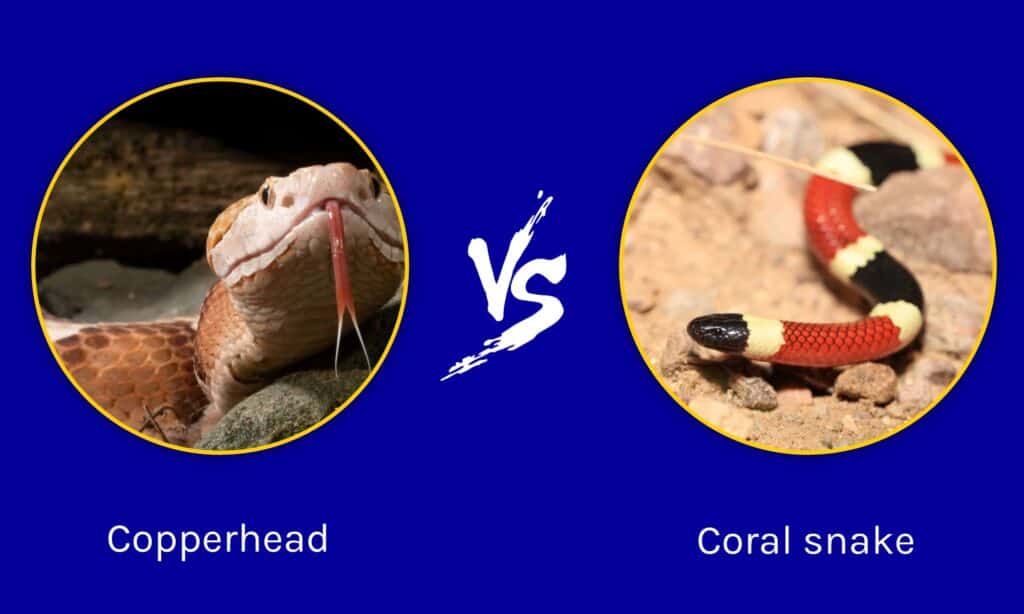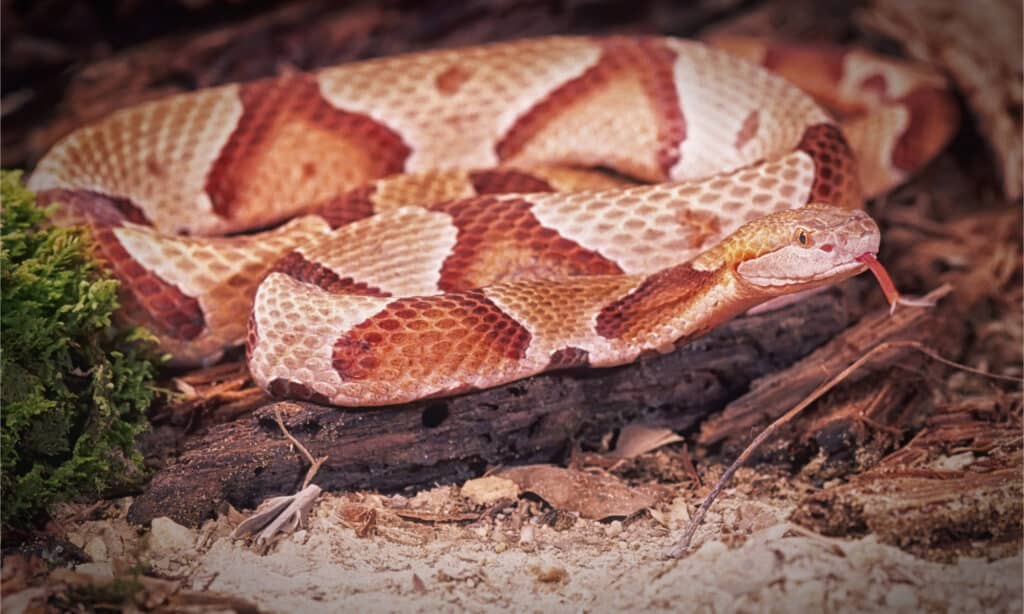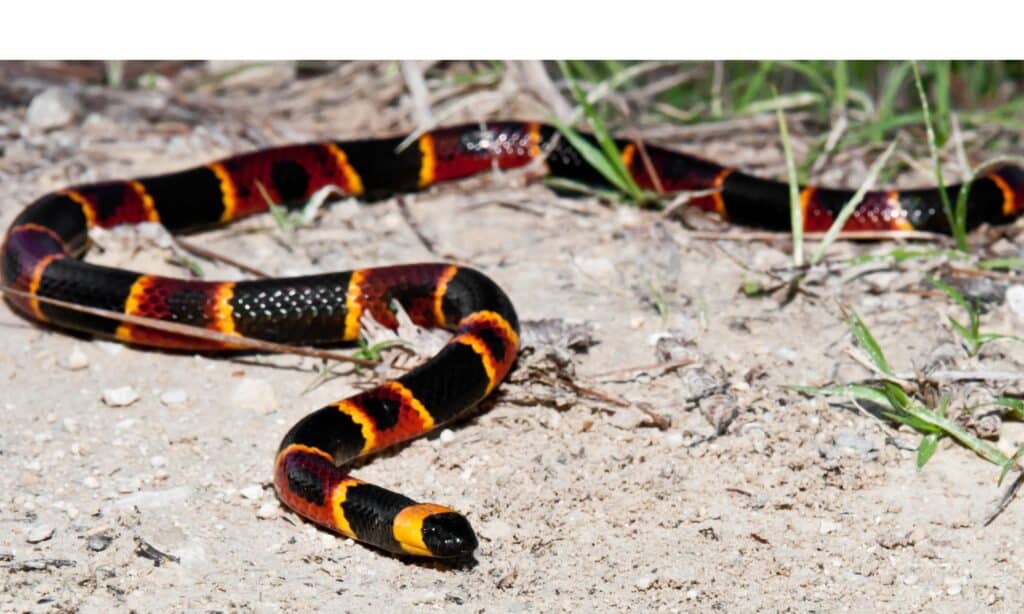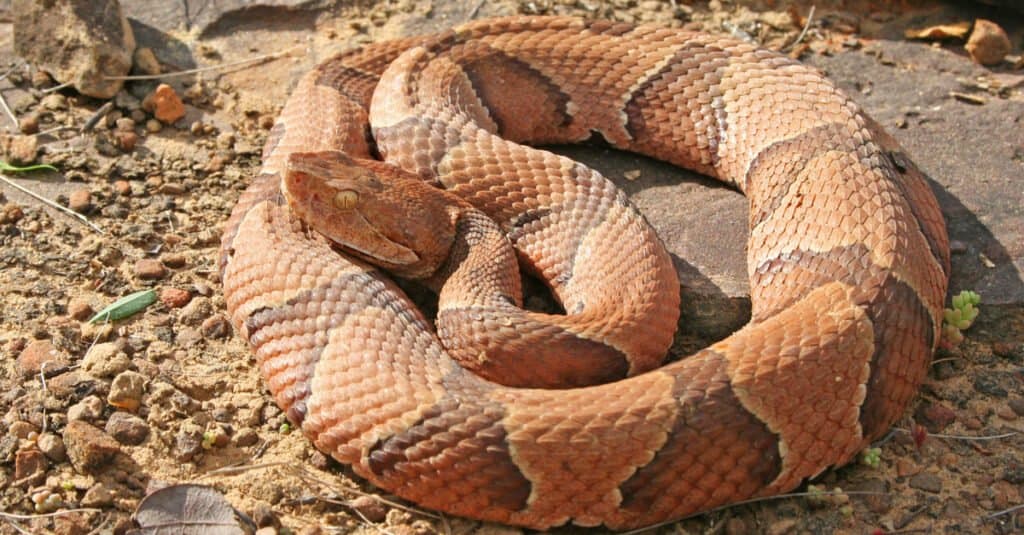Copperheads and coral snakes are two venomous North-American snakes. Copperheads are solitary pit vipers known to bite more people than any other snake in the USA, despite their non-aggressive natures. Coral snakes, on the other hand, are elapids subdivided into two groups: Old and New World snakes.
Since both snakes are native to the southeastern United States, a lot of people confuse both species which leads to quite a bit of misinformation. Copperheads and coral snakes might have some similarities, but they are very different snakes. This article explores these snakes, taking a special look at their venom. Let’s get right into it! Copperhead vs Coral snakes: what are the main differences?
Comparing a Copperhead and a Coral Snake

| Copperhead | Coral Snake | |
|---|---|---|
| Scientific Name | Agkistrodon contortrix, Agkistrodon laticinctus | Micrurus fulvius, Micrurus tener |
| Snake Family | Pit viper | Elapid |
| Habitat | Southeastern United States | Southern U.S. from Arizona to Florida |
| Species Worldwide | Previously 5, currently 2 – Eastern copperhead and broad-banded copperhead | 16 species of Old World, 80+ species of New World |
| Size | 0.2 – 0.7 pounds (3.2 – 11.2 ounces) 20-37 inches long | 0.5-5 pounds (8- 80 ounces) 11-47.5 inches long |
| Description | Copper or orange-red triangular heads Pale brown to pinkish-brown background skin Hourglass-shaped markings that are colored copper to reddish-brown Dorsal and ventral scales | Round heads Round pupils Mostly tricolored (bicolor occurs rarely) Various combinations of yellow, black, white, and red rings Smooth scales Short tails |
| Fang type | Solenoglyphous | Proteroglyphous |
| Hunting style | Heat-sensing/ infrared pits that help them detect the movement and presence of prey. Stalk and ambush hunters. They subdue with venom before swallowing their prey whole. Diurnal in the spring and fall, nocturnal during the summer. | Ambush hunters They bite and hold their victims for a few seconds to inject venom. Diurnal in the spring and fall, nocturnal during the summer. |
| Diet | Carnivore Toads, small mammals, frogs, lizards, rats, small snakes, and even other copperheads | Carnivore Toads, small mammals, frogs, lizards, rats, small snakes, and even other coral snakes |
| Bite | Extremely painful bites Temporal damage to tissue Bites are fairly common as people unknowingly step on/near them a lot | Bite marks are easily missed and often do no obvious damage to tissue. They are often painless Bites are rare |
| Venom composition | Primarily hemotoxic | Primarily neurotoxic |
| Symptoms of envenomation | Extreme pain, severe nausea, and swelling. | Vomiting, drooping eyes & slurred speech, severe nausea, paresthesia, paralysis, death. |
| Maximum venom yield | Eastern copperhead: 85mg | Eastern coral snakes: 38mg |
| Average venom yield | Eastern copperhead: 26mg | Eastern coral snakes: 10-12mg |
| Lethal venom yield | Eastern copperhead: 85-100mg | Eastern coral snakes: 4-6mg |
| Anti-venom? | Yes. | Yes. |
| Defense Mechanisms | Venom Musk | Venom |
| Temperament | They freeze when humans come near. This causes people to unknowingly step on/near them a lot and get bitten | Non-aggressive Will always try to escape before defending itself |
Key Differences Between a Copperhead and a Coral Snake
The main differences between a coral snake and a copperhead lie in their size, taxonomy, venom yield, fang type, and diet among others.
Copperhead vs Coral Snake: Taxonomy

Copperheads are venomous pit vipers while coral snakes are venomous elapids.
©outdoorsman/Shutterstock.com
Copperheads are venomous pit vipers. This means that they have infrared pits which they use to locate their warm-blooded prey. They also have long solenoglyphous fangs that work very similarly to hypodermic needles (the common types used in hospitals).
Coral snakes are venomous elapids and consequently have short and fixed fangs at the front of their mouths.
Copperhead vs Coral Snake: Description
Both copperheads and coral snakes vary in length depending on the subspecies. However, the shortest coral snake is the Sonoran coral snake and it can be as short as 11 inches. The longest coral snake recorded was a 47.5-inch eastern coral snake. Copperheads, on the other hand, measure anywhere from 20-37 inches.
Copperheads have copper or orange-red colored triangular heads. This unique feature is where their name is derived from. Coral snakes, however, have round heads and round pupils in contrast to copperheads’ elliptical pupils.
Coral snakes are usually tri-colored with various yellow, black, white, and red ring patterns. Some specimens are bicolored but this is rare.
Copperhead vs Coral Snake: Venom

Coral snakes have neurotoxic venom, while copperheads have hemotoxic venom.
©iStock.com/JasonOndreicka
Copperheads have hemotoxic venom which attacks the muscle tissue. However, if treated, the effects of the copperhead’s venom are reversible but that is not to say that they aren’t deadly. The fatality rate for these snakes is about 0.01%.
Coral snakes have neurotoxic venom which is one of the fastest-acting venom. Neurotoxins attack the nervous system and stop the transmission of signals. This leads to paralysis and can cause death. Coral snakes are more venomous than copperheads.
A common belief is that they must chew to inject venom — this is false. Coral snakes often eat other snakes and the “chewing” behavior is common among snakes that regularly eat other snakes. Scientists believe it might be an attempt to prevent their prey’s escape.
Copperhead vs Coral Snake: Bite

Copperhead bites are more painful than coral snake bites.
©Creeping Things/Shutterstock.com
Copperheads make up for their lack of strong venom with excruciatingly painful bites. If a bitten person can get treatment in time, the worst part of the experience will possibly be the bite. This isn’t the case with coral snakes. Their bites are sometimes painless and may not even leave a mark.
A copperhead’s bite is often accompanied by nausea and swelling but in many cases, coral snake bites don’t exhibit symptoms until it’s too late for treatment. Since neurotoxins cause paralysis of muscles, the venom can affect the diaphragm. The diaphragm is the breathing muscle and paralysis of this muscle will make the victim unable to breathe. This, of course, will result in death.
Copperhead vs Coral Snake: Venom Yield
Copperhead snakes have a maximum venom yield of 85 mg, while coral snakes have a maximum yield of 38 mg. Even though copperheads’ fangs hold more venom, what really matters is the potency. It takes 85 to 100 mg of copperhead venom to kill a healthy human.
Most copperhead bites are dry bites but when they do inject venom, they inject an average of 26mg, which is not nearly enough to kill a human. However, sometimes, copperheads inject higher than their average yield. This, combined with victims refusing to see doctors due to underestimation of the venom is why 0.01% of people bitten by copperheads lose their lives.
Coral snakes have a maximum venom yield of 38 mg but only need 4-6 mg to kill a healthy person, thus making their venom strong enough to kill five people in a single bite. Without anti-venom and treatment, a large number of bite cases would result in death.
If you are bitten by a snake, get immediate emergency help. Do not attempt to treat yourself in any way if you want to give yourself the best chance at survival. It is also important to remember that despite their deadly venom, snakes help to keep several pest populations in check. They are important to the ecosystem and to every one of us indirectly.
The photo featured at the top of this post is © Scott Delony/Shutterstock.com
Discover the "Monster" Snake 5X Bigger than an Anaconda
Every day A-Z Animals sends out some of the most incredible facts in the world from our free newsletter. Want to discover the 10 most beautiful snakes in the world, a "snake island" where you're never more than 3 feet from danger, or a "monster" snake 5X larger than an anaconda? Then sign up right now and you'll start receiving our daily newsletter absolutely free.
Thank you for reading! Have some feedback for us? Contact the AZ Animals editorial team.







